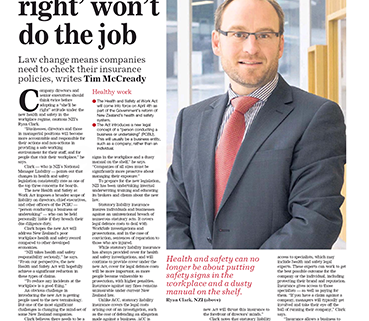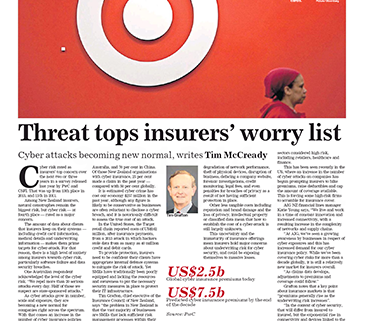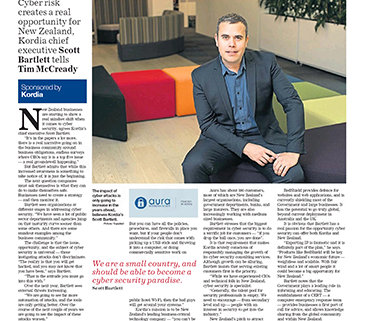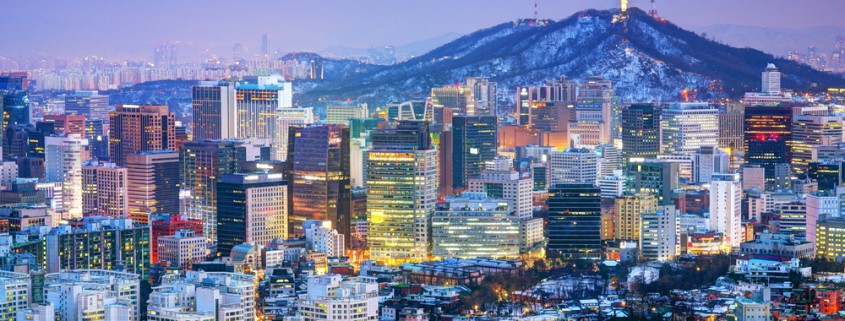http://nzh.tw/11611363
Law change means companies need to check their insurance policies, writes Tim McCready.
Company directors and senior executives should think twice before adopting a “she’ll be right” attitude under the new health and safety in the workplace regime, cautions NZI’s Ryan Clark.
“Businesses, directors and those in managerial positions will become more accountable and responsible for their actions and non-actions in providing a safe working environment for their staff, and for people that visit their workplace,” he says.
Clark – who is NZI’s National Manager Liability – points out that changes in health and safety legislation consistently rate as one of the top three concerns for boards.
The new Health and Safety at Work Act imposes a broader scope of liability on directors, chief executives, and other officers of the PCBU – “person conducting a business or undertaking” – who can be held personally liable if they breach their due diligence duty.
Clark hopes the new Act will address New Zealand’s poor workplace health and safety record compared to other developed economies.
“NZI takes health and safety responsibility seriously,” he says. “From our perspective, the new Health and Safety Act will hopefully achieve a significant reduction in these types of claims.
“To reduce any incidents at the workplace is a good thing.”
An obvious challenge in introducing the new Act is getting people used to the new terminology. But one of the most significant challenges is changing the mind-set of some New Zealand companies.
Clark believes there needs to be a change away from a “she’ll be right” attitude, towards an understanding that directors and companies must provide a safe environment for their employees, and that the new Act has consequences.
While many larger companies have brought in consultants to review their health and safety processes, Clark notes that changing the attitude of small- to medium-sized businesses will be particularly important.
“The most important thing for New Zealand companies or boards to appreciate is that health and safety can no longer be about putting safety signs in the workplace and a dusty manual on the shelf,” he says. “Companies of all sizes must be significantly more proactive about managing their exposure.”
To prepare for the new legislation, NZI has been undertaking internal underwriting training and educating its brokers and clients about the new law.
Statutory liability insurance insures individuals and businesses against an unintentional breach of numerous statutory acts.
It covers legal defence costs to deal with WorkSafe investigations and prosecutions, and in the case of conviction, sentences of reparation to those who are injured.
While statutory liability insurance has always provided cover for health and safety investigations, and will continue to provide cover under the new Act, cover for legal defence costs will be more important, as more people become vulnerable to prosecution, with higher penalties.
Insurance against any fines remains uninsurable under current New Zealand law.
Unlike ACC, statutory liability insurance covers the legal costs arising out of an investigation, such as the cost of defending an allegation made against a business.
ACC is capped at 80 per cent of lost earnings, and the Sentencing Amendment Act 2014 means the Courts are now able to enforce reparation orders to top up this shortfall, as well as recover medical bills and loss of benefits.
Unlike ACC, an insurance policy is capped only at the level of insurance a business purchases.
“Many New Zealand companies already have statutory liability insurance, but it is often only considered a bolt-on, with not much thought put into it,” says Clark.
“As the policy covers not only companies, but directors as well, I am sure the new Act will thrust this insurance to the forefront of directors’ minds.”
Clark notes that statutory liability has historically been underinsured. Companies may take $250,000 or $500,000 limits, but when taking the new Act into consideration, this would probably be significant underinsurance.
Clark encourages companies to give careful consideration as to whether they have the right insurance policies in place. Defending a prosecution for a workplace injury can be expensive and time consuming, and has the potential to adversely affect the ongoing viability of a business.
Statutory insurance can provide access to specialists, which may include health and safety legal experts. These experts can work to get the best possible outcome for the company or the individual, including protecting their brand and reputation.
Insurance gives access to those specialists – as well as paying for them. “If you have a claim against a company, managers will typically get involved and take their eye off the ball of running their company,” Clark says.
“Insurance allows a business to not only get access to those specialists, but to transfer the financial expenditure to the insurer’s balance sheet – not theirs. Management can get on with running the business, and minimise the time they are distracted.”
The changes are not expected to result in an immediate jump in insurance premiums. Any future increases will likely be reactive rather than proactive.
It will depend on how the regulators use their new authority and regulatory tools, and how much of an example they make of New Zealand companies.
Healthy work
- The Health and Safety at Work Act will come into force on April 4th as part of the Government’s reform of New Zealand’s health and safety system.
- The Act introduces a new legal concept of a “person conducting a business or undertaking” (PCBU). This will usually be a business entity, such as a company, rather than an individual.










